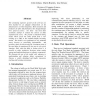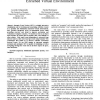524 search results - page 14 / 105 » Providing Spatial Navigation for the World Wide Web |
EUROMICRO
1998
IEEE
13 years 12 months ago
1998
IEEE
The continuing explosive growth of the web has not been matched by an adequate enhancement of the infrastructure on which it depends. Both consumers and producers are often left f...
WSE
2002
IEEE
14 years 15 days ago
2002
IEEE
Every day, new information, products and services are being offered by providers on the World Wide Web. At the same time, the number of consumers and the diversity of their intere...
URBAN
2008
13 years 7 months ago
2008
Technologies associated with the second-generation of the World-Wide Web enable virtually anyone to share their data, documents, observations, and opinions on the Internet. In les...
ICRA
1993
IEEE
13 years 11 months ago
1993
IEEE
An issue central to the navigation problem is memory. Traditional systems build symbolic maps of the world for navigational reference. Reactive methods, in contrast, eliminate or m...
ISI
2007
Springer
14 years 1 months ago
2007
Springer
—Semantic Event Tracker (SET) is a highly interactive visualization tool for tracking and associating activities (events) in a spatially and Multimedia Enriched Virtual Environme...


